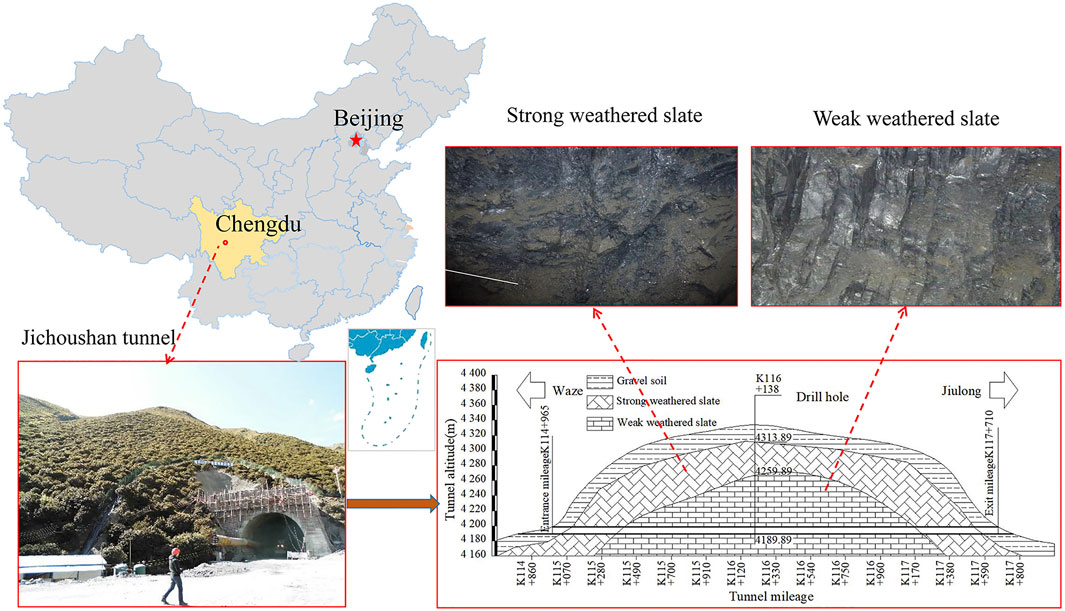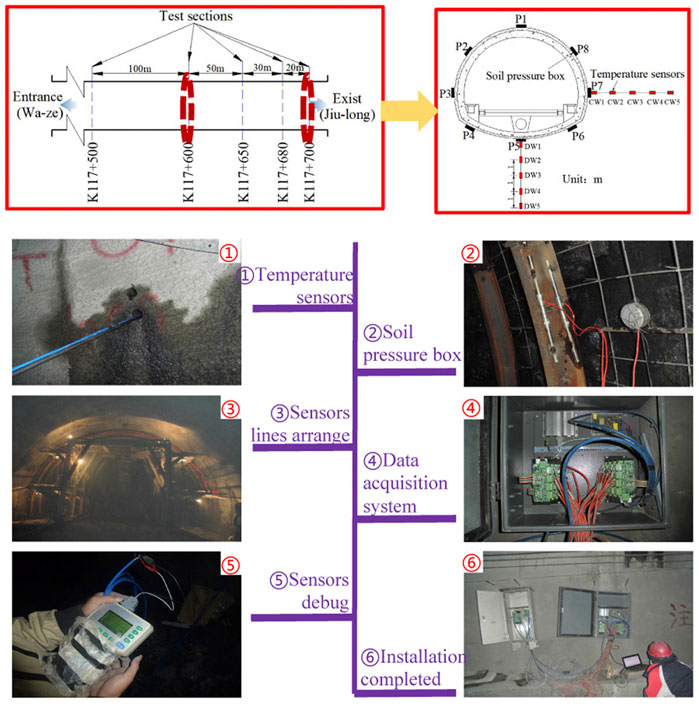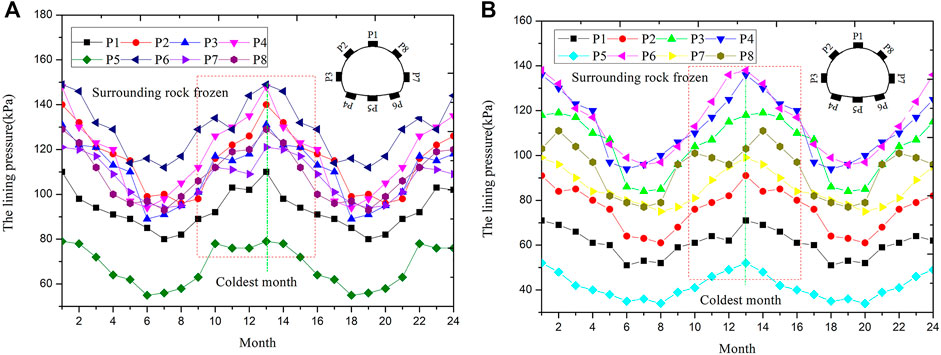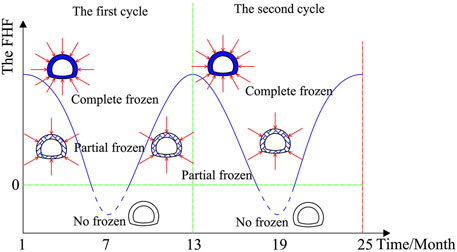- 1Xi’an University of Architecture and Technology, Xi’an, China
- 2Shaanxi Key Laboratory of Geotechnical and Underground Space Engineering, Xi’an, China
- 3Shaanxi Provincial Land Engineering Construction Group Co., Ltd., Xi’an, China
- 4School of Civil Engineering and Architecture, Hubei University of Arts and Science, Xiangyang, China
The frost heave force (FHF) is one of the most important reason of inducing freezing damages of tunnel in seasonal frozen regions. Analyzing the change law of FHF is helpful to design for avoiding freezing damages in the tunnel lining. Field measurement is an approved method used in mechanical analysis of tunnel lining, however, it is difficult to measure the FHF directly, which is changed coupled with the original surrounding rock pressure (OSRP). In this paper, in order to clarifying the change law of the FHF, a new measuring method was presented. The best advantage of this method is that the FHF could be separated from the OSRP by measuring the surrounding rock temperature and the lining pressure at the same time. A lot of field measurement work about the FHF was conducted based on Jichoushan tunnel and the change law of the FHF was analyzed using the presented method. The results can provide preference for the antifreeze design of tunnel in seasonal cold regions.
Introduction
China consists of about 54% seasonal frozen surface, where a large number of tunnels have been constructed for the increasing requirement of transportation (Feng et al., 2016; Lai et al., 2018; Feng et al., 2019; Fan et al., 2019; Fan et al., 2020). These tunnels in cold region are often affected by the seasonal frost heave force (FHF) (Zhang et al., 2004; Lai at al., 2005; Bronfenbrener, 2009; Gao at al., 2012; Lai et al., 2016; Feng at al., 2017; Hu at al., 2018; Wang et al., 2018; Xia et al., 2018; Xia et al., 2018b; Lyu et al., 2020; Zhao et al., 2020; Wang et al., 2021a; Wang et al., 2021b), causing lining cracks, drainage system failure, etc. A few tunnels even are abandoned due to the freezing damages (Feng at al., 2017). These damages induced by FHF seriously threaten the tunnel operation safety. It is of great significance to investigate the change law of the FHF on the tunnel lining for avoiding the freezing damages of tunnel in seasonal cold regions (Tan et al., 2011; Jiang et al., 2016; Li et al., 2017; Zeng et al., 2017; Liu et al., 2018; Xia et al., 2018; Huang et al., 2020).
As is known to us all, the FHF is one of the most important reason of causing freezing damages in the tunnel lining (Lai et al., 2016), so it’s helpful for us to investigate the change law of FHF. Field measurement method is an approved approach to study the mechanical properties of tunnel lining, however, it is difficult to measure the FHF directly due to the effect of the OSRP. In fact, the OSRP and the FHF are coupled acting on the lining support, we can’t easily distinguish them. Even though, many researches about field measurement have been done to understand the change law of the tunnel temperature (Kozlowski, 2009; Tan et al., 2014; Zhou et al., 2016; Jun et al., 2017; Li et al., 2017; Xing et al., 2017; Zeng et al., 2017; Zhang G et al., 2017; Zhao et al., 2019; Wu et al., 2020). Jun et al. (2017) measured the temperature of the air inside the tunnel, the road pavement, and the lining surfaces of a total of 104 surveyed tunnels, then he analyzed the statistical law of data. Xing et al. (2017) presented a new innovation system for temperature measurement, and monitored the temperature in the process of construction and operation of tunnel lining and insulation layer. Zhao et al. (2019) gave a distributed temperature monitoring system for tunnels in cold regions and completed a long-term, real-time and multi-channel automatic temperature test in different positions in the tunnel. As can be seen that there are few research on FHF using field measurement method. Currently, the research about the FHF is almost belong to theoretical and experimental work (Tan et al., 2011; Liu et al., 2018; Xia et al., 2018; Huang et al., 2020). Some models considering the influence of phase-change, latent heat, and other factors have been studied. Li et al. (2017) built a coupled heat-water model for the tunnel in cold regions on the basis of energy and mass conservation principles, and gave a scientific balance between the safety and the economy. Meanwhile, in order to study the distribution of FHF, some investigations using lab tests were also conducted. Zeng et al. (2017) performed a similarity simulation model test with 1:30 geometric scale based on practical horseshoe railway tunnel section to investigate the couple effect of convection-conduction. Zhang M et al. (2017) proposed a two-phase closed thermosphon group (TPCT), which is applied to adjust and control the ground temperature for a shallow tunnel section.
As seen from above, although a lot of researches about the FHF have been done (Tan et al., 2011; Li et al., 2017; Zeng et al., 2017; Zhang G et al., 2017; Liu et al., 2018; Xia et al., 2018; Huang et al., 2020; Kang et al., 2021), few researches about the FHF has been conducted by field measurement method. Up to now, the field measured data about the FHF is very scarce, since we can’t easily distinguish the FHF from the OSRP. In this paper, a new method of measuring the FHF was proposed. The measuring system includes the temperature sensors, soil pressure box and the data acquisition section. The surrounding rock temperature and the lining pressure were tested synchronously. The FHF was defined as the D-value of the average value of the month in negative temperature and the average value of the month in positive temperature. In the last, the change law of the FHF was analyzed with seasonal time, and the frost heave mechanism was discussed. The results could provide reference for the antifreeze design of tunnels in seasonal cold regions.
Project Overview
Background
The Jichoushan tunnel is an important part of Waze-Jiulong highway in Szechwan province, which is the only connection to Jiulong County from Chengdu. The site of the Jichoushan tunnel is located in the Qinghai-Tibet plateau. The mean annual precipitation is about 906 mm, the maximum per day precipitation is 56.9 mm. The surrounding rock of tunnel is gravel soil on the surface, strong weathered slate in the middle and weak weathered slate in the inner. The tunnel location and geological profile is shown in Figure 1. According to statistics of the meteorological data, the freeze period of the tunnel area is about 6 months in a year. The extremely low temperature in winter could reach −20°C, and the extremely high temperature in summer could reach 35°C. Tunnel temperature has an obviously characteristic of seasonal variation, which make contributions to seasonal change of the FHF.
Field Measurement Principle
The FHF refers to the force exerted on the support system due to frost heave after the frozen-thaw zone of confined surrounding rock is frozen (Bronfenbrener,2009; Zhang et al., 2004; Lai at al., 2005; Gao at al., 2012; Feng at al., 2017; Li et al., 2017; Zeng et al., 2017; Hu at al., 2018; Liu et al., 2018; Wang et al., 2018; Xia et al., 2018a; Huang et al., 2020; Lyu et al., 2020). Based on the NATM design concept (Zhang et al., 2018), the surrounding rock has self-supporting capacity and will bear part of the FHF, but when frost heave occurs, a large part of the FHF will act on the lining support. Therefore, measuring the change of the stress of the lining support can reflect the change of FHF. However, when the surrounding rock frozen, the FHF and OSRP coupled act on the lining support, we can’t easily distinguish the FHF from the OSRP, so we can’t obtain the FHF directly by the field testing method. In order to reflect the change law of the FHF, a method of measuring FHF was proposed in this paper. This method is measuring the surrounding rock temperature and the lining pressure at the same time via the monitoring system, which includes the temperature sensors, soil pressure box and the data acquisition section. The FHF could be calculated indirectly from the lining pressure. The principle is as follows: firstly, the variation law of surrounding rock temperature was recorded, meanwhile, the lining pressure was measured synchronously by means of the testing system; secondly, the OSRP was obtained by the lining pressure of unfrozen period, the OSRP + FHF was obtained by the lining pressure of frozen period, the D-value between the lining pressure before and after the surrounding rock frozen is the FHF. We could analyzed the change law of the FHF by the D-value. In addition, in order to make the data more representative, the mean values of lining pressure corresponding to the highest temperature from July to September are taken as the OSRP, and the mean values of lining pressure corresponding to the lowest temperature from December to February are taken as the sum of OSRP and the FHF. The D-value between the two mean values is defined as the generalized FHF. We can obtain the frost heave characteristic of the tunnel by analyze the FHF and the generalized FHF from the recorded lining pressure data.
Field Measurement Programme
As can be seen from the previous section, the FHF is closely related to the surrounding rock temperature of the tunnel. In order to measure the change law of the FHF, we should measure the surrounding rock temperature and the lining pressure at the same time. In this paper, two typical sections K117 + 700 (hereinafter referred to as section 700) and section K117 + 600 (hereinafter referred to as section 600) were set in the exit zone of Jichoushan tunnel (shown in Figure 2). The measuring system includes the temperature sensors, the soil pressure box and the data acquisition section. The surrounding rock temperature and the lining pressure of the two sections were measured by this system respectively. The surrounding rock temperature was measured using temperature sensors. In each section, two hole of 4 m depth was set at side wall and invert part respectively. Every hole includes five measuring points (CW1∼CW5 at side wall, DW1∼DW5 at invert), where installed the temperature sensors. The interval of each point is 1 m. The lining pressure was measured using the soil pressure box. There are eight points around the lining for measuring lining pressure in each section. The data was recorded four times a day at eight, twelve, sixteen and twenty respectively. In the last, the synchronous change law of the surrounding rock and the lining pressure was obtained, then we can analyse the change law of the FHF by the method proposed above.
The correct installation of sensors is the premise of obtaining accurate data. According to the site installation, we recorded some difficulties of field work. All the sensors should be installed keep up with the progress of tunnel construction (shown in Figure 2). Firstly, to put the temperature sensors on the correct location in the hole, a steel bar of 4 m long was used to fix the temperature sensors, then the steel bar was put into the hole, in which the temperature sensors were protected from damage during installation by geotextile wrapping. After the steel bar with sensor was installed in place, the hole was sealed densely with cement. Secondly, the soil box was fixed on the steel mesh using iron wire binding method, then it was covered with shotcrete. When all the sensors of each section were installed perfectly, the lines should be arranged to the data acquisition system. In the last, each sensor should be debugged before formal data acquisition to ensure its normal operation.
Field Measurement Results
Surrounding Rock Temperature
According to the method proposed above, the surrounding rock temperature of section 700 and section 600 was measured firstly. The results of the two sections were shown in Figure 3A–D. It can be seen that the variation law of surrounding rock temperature in radial 2 m is basically the same as that of tunnel environment temperature. The frozen period is January, February, March, November, December of a year. With the increase of radial depth of surrounding rock, the temperature variation amplitude decreases gradually. When the depth over 3m, the surrounding rock temperature basically unchanged, we can infer that the maximum freezing depth of surrounding rock is between 2 and 3 m. Because of the limitation of temperature sensors layout, the true value of freezing depth could not be measured exactly. The temperature variation of CW1 closing to lining surface is most obvious recently affected by tunnel environmental temperature. In section 700 line CW, the lowest temperature in January is close to - 10°C, the highest temperature in August is close to 10°C and higher than the original temperature of surrounding rock, which indicates that the closer to the lining surface, the more obvious the freeze-thaw effect is. The surrounding rock temperature is negative from Nov. to Apr. of the next year, which will lead to a significant frost heave phenomenon in tunnel lining.
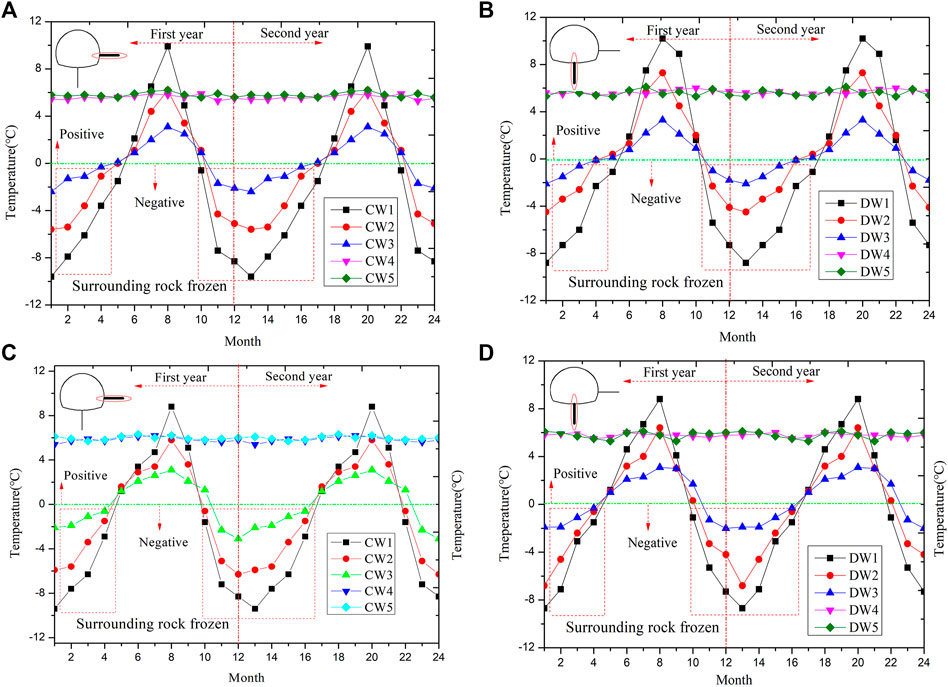
FIGURE 3. Radial temperature change rule of surrounding rock. (A) Section 700-line CW (B) Section 700-line DW (C) Section 600-line CW (D) Section 600-line DW.
From Figures 3A,B, the CW1 in section 700 line CW is −9.6°C in January, 9.9°C in August, the DW1 in section 700 line DW is −8.8°C in January, 10.2°C in August. It can be seen that the invert temperature is higher than the side wall, we could infer that the frost heave phenomenon should be more serious in the side wall in the same section. From Figures 3A,C, the CW1 in section 700 line CW is −9.6°C in January, 9.9°C in August, the CW1 in section 600 line CW is −9.4°C in January, 8.8°C in August. It can be seen that the temperature change range in section 700 was bigger than that in section 600. We could infer that section 700 would suffer more severe frost heaving damage, which is closer to the tunnel portal. In the next part, we will measure the lining pressure and analyse the change law of the FHF, combing the change of the surrounding rock temperature.
The Lining Pressure
Though, we can’t measure the FHF directly, we can measure the lining pressure by the soil box. We can indirectly analyze the change law of the FHF through the change of lining pressure, combing the change of the surrounding rock temperature. According to the measuring plan above, section 700 and section 600 are taken as the typical measuring sections. The change law of the lining pressure in section 700 and section 600 were shown in Figures 4A,B. We can see that the lining pressure changed with seasonal time, the maximum appears in January. Because of the surrounding rock temperature is lower than 0°C in January, February, March, November and December, the lining pressure also change bigger subjected to the freezing phenomenon of surrounding rock. The lining pressure recorded by the data acquisition system contains the OSRP and the FHF. According to the principle of calculation of the FHF, if we want to get the FHF, the OSRP must be excluded. As we know, if the surrounding rock not frozen, the lining support will be acted by the surrounding rock pressure only. So, the OSRP could be get from the data acquisition in July, August and September, when the surrounding rock not frozen.
Analysis and Discussion
The FHF Response to Temperature
To investigate the relationship between the FHF and the surrounding rock temperature, the temperature of CW1 and DW1, the lining pressure of P5 and P7 of section 700 and section 600 were shown in Figure 5A,B. The CW1 and DW1 could represent the temperature change in the side wall and the invert, the P5 and P7 could reflect the FHF change. From Figure 5A, the lowest temperature appeared in January, in which the FHF reached the maximum. Then, with the time go on, the temperature gradually increased and the FHF decreased. The highest temperature appeared in August, in which the FHF changed to the minimum. Further, with time goes on, the temperature become lower and the FHF become bigger. In the whole, the FHF and temperature have opposite periodic variation in 1 year. From Figure 5B, we can see that section 600 has the similar changing rules. The difference is that the peak values of temperature and FHF are smaller than section 700.
The FHF in the Lining
According to the definition, the FHF refer to the force acting on lining structure after the surrounding rock frozen. The lining pressure we got contains the OSRP and FHF. In order to more intuitive display the change of FHF before and after freezing of surrounding rock, we deem that the average value of July, August and September is the OSRP before frozen, and the average value of January, February, December is the sum of OSRP and FHF after frozen. The lining pressure of section 700 and section 600 in each point around the lining before and after frozen were shown in Figures 6A,B. We can see that the lining pressure is small before the surrounding rock frozen, it had a obvious increase in each point after the surrounding rock frozen. The increase in each point is different, the P5 is the minimum in section 700 and section 600. As the surrounding rock temperature, the invert temperature change is small, so the FHF in P5 is small too. But what’s interesting is that the P7 of section 700 and section 600 is small, which remind us that the surrounding rock is not the only factor affecting the FHF, also the water condition, the surrounding rock degree are the influence factors. What’ more, the average of FHF in section 700 is 18.78 kPa, and section 600 is 18.28 kPa, which is in good agreement with the surrounding rock temperature change. This part presented the lessons that we should take more attention to the tunnel portal in the insulation design, and all the factors of temperature, water and surrounding rock degree should be considered.
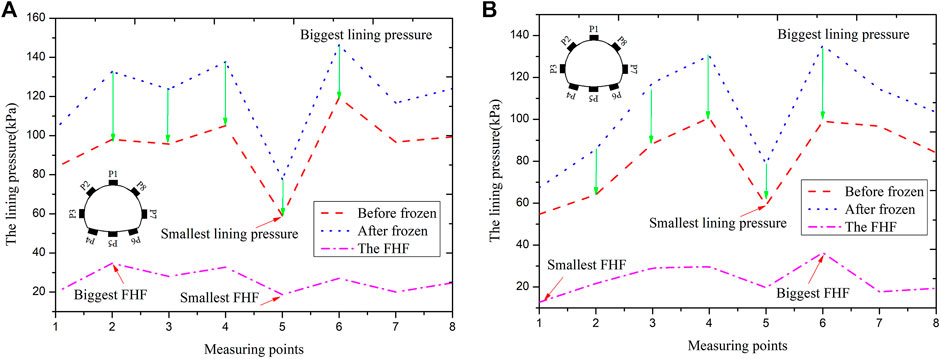
FIGURE 6. Lining pressure comparison of frozen and unfrozen surrounding rock. (A) Section 700 (B) Section 600.
The FHF Change With Time
To analyse the periodic characteristics of the FHF, the average value of July, August and September was taken as the OSRP, the D-value of the lining pressure and the OSRP in each point is the FHF. The change law of the FHF in P1 to P8 around the lining were shown in Figures 7A,B. As can be seen that the FHF has a period characteristics with time in the sine function type, it become bigger with the temperature lower and reached the maximum in the January. It should be noted that the FHF in May, June, July and August is negative value, which represent no FHF in this period time. We can use a simple sine function to describe the change law of the FHF. In addition, the FHF in P4 and P6 was more obvious than in P1, which could be inferred that more protection is needed at the arch foot on both sides of the tunnel.
Discussion About Frost Heave Progress
From the measurement results above, we can see that the FHF was closely related to the change of surrounding rock temperature. The frost progress in a year was discussed (shown in Figure 8). In January, the surrounding rock temperature is the lowest, the frozen depth in the surrounding rock is biggest at this point, which mean that the frost layer is totally frozen and the FHF reaches the maximum. In March, the surrounding rock temperature became higher, the frozen depth in surrounding rock became smaller, which mean that the frost layer is partial frozen and the FHF became smaller. In July, the surrounding rock temperature is highest, there is no frost in the surrounding rock, also no FHF exist. We can infer that the FHF changes periodically as a sine function with the time. The FHF would became obvious subjected to the lower temperature in winter, which prompt that some anti-freezing measures must be taken at this point. The change of FHF present the lessons for us to frost resistance design of tunnel in cold regions.
Conclusion
In this paper, a simple and effective measurement method of the FHF was proposed, some field work was conducted based on Jichoushan tunnel, and the change law of the FHF was analyzed, the main conclusions are as follows:
1) A method of measuring the FHF was proposed, the measuring system includes the temperature sensors, soil pressure box and the data acquisition section. The calculation method of FHF was presented.
2) The surrounding rock temperature and the lining pressure were measured synchronously. The frost layer is limited to 3 m, the closer to the lining surface, the more obvious the temperature change. The lining pressure, contains the OSRP and the FHF, changed with seasonal time, the maximum appears in January
3) The average of FHF in section 700 is 18.78 kPa, and section 600 is 18.28 kPa, which is in good agreement with the surrounding rock temperature change. The FHF of each point has a period characteristics with time in the sine function type. More attention should be taken to the tunnel portal in the insulation design, and all the factors of temperature, water and surrounding rock degree should be considered.
Data Availability Statement
The original contributions presented in the study are included in the article/Supplementary Material, further inquiries can be directed to the corresponding author.
Author Contributions
YZ: Putting forward the conceptualization and methodology; SF: Writing the original draft manuscript; DY: Conducting the field measuring work; FZ: Writing and reviewing the manuscript.
Funding
This study is funded by the Postdoctoral Funds in China (2018M643809XB); the Youth project of basic research program of Natural Science in Shaanxi Province (2019JQ-762); the Special project of Education Department of Shaanxi Province (20JK0709); the Scientific Research Plan Guiding Project of Hubei Provincial Education Department (B2020143); Open Discipline Fund of Graduate Office of Hubei University of Arts and Sciences (XK2021035).
Conflict of Interest
Author DY was employed by the company Shaanxi Provincial Land Engineering Construction Group Co., Ltd.
The remaining authors declare that the research was conducted in the absence of any commercial or financial relationships that could be construed as a potential conflict of interest.
Publisher’s Note
All claims expressed in this article are solely those of the authors and do not necessarily represent those of their affiliated organizations, or those of the publisher, the editors and the reviewers. Any product that may be evaluated in this article, or claim that may be made by its manufacturer, is not guaranteed or endorsed by the publisher.
References
Bronfenbrener, L. (2009). The Modelling of the Freezing Process fine-grained Porous media: Application to the Frost Heave Estimation. Cold Reg. Sci. Tech. 56 (2), 130–134. doi:10.1016/j.coldregions.2008.11.004
Fan, J., Jiang, D., Liu, W., Wu, F., Chen, J., and Daemen, J. (2019). Discontinuous Fatigue of Salt Rock with Low-Stress Intervals. Int. J. Rock Mech. Mining Sci. 115 (3), 77–86. doi:10.1016/j.ijrmms.2019.01.013
Fan, J., Liu, W., Jiang, D., Chen, J., Tiedeu, W. N., and Daemen, J. J. K. (2020). Time Interval Effect in Triaxial Discontinuous Cyclic Compression Tests and Simulations for the Residual Stress in Rock Salt. Rock Mech. Rock Eng. 53, 4061–4076. doi:10.1007/s00603-020-02150-y
Feng, Q., Fu, S., Wang, C., Liu, W., Wang, Y., and Qiao, W. (2019). Analytical Elasto-Plastic Solution for Frost Force of Cold-Region Tunnels Considering Anisotropic Frost Heave in the Surrounding Rock. KSCE J. Civ. Eng. 23 (9), 3831–3842. doi:10.1007/s12205-019-1446-7
Feng, Q., Jiang, B.-S., Zhang, Q., and Wang, G. (2016). Reliability Research on the 5-Cm-Thick Insulation Layer Used in the Yuximolegai Tunnel Based on a Physical Model Test. Cold Regions Sci. Tech. 124, 54–66. doi:10.1016/j.coldregions.2016.01.001
Feng, Q., Liu, W.-w., and Jiang, B.-S. (2017). Analytical Solution for the Stress and Deformation of Rock Surrounding a Cold-Regional Tunnel under Unequal Compression. Cold Regions Sci. Tech. 139, 1–10. doi:10.1016/j.coldregions.2017.04.003
Gao, G. Y., Chen, Q. S., Zhang, Q. S., and Chen, G. Q. (2012). Analytical Elasto-Plastic Solution for Stress and Plastic Zone of Surrounding Rock in Cold Region Tunnels. Cold Regions Sci. Tech. 72, 50–57. doi:10.1016/j.coldregions.2011.11.007
Hu, Q. J., Shi, R. D., and Hu, Y. (2018). Method to Evaluate the Safety of Tunnels through Steeply Inclined Strata in Cold Regions Based on the Sidewall Frost Heave Model. J. Perform. Constr. Facil. 32, 4. doi:10.1061/(ASCE)CF.1943-5509.0001165
Huang, L., Sheng, Y., Wu, J., He, B., Huang, X., and Zhang, X. (2020). Experimental Study on Frost Heaving Behavior of Soil under Different Loading Paths. Cold Regions Sci. Tech. 169, 102905. doi:10.1016/j.coldregions.2019.102905
Jiang, D., Fan*, J., Chen, J., Li, L., and Cui, Y. (2016). A Mechanism of Fatigue in Salt under Discontinuous Cycle Loading. Int. J. Rock Mech. Mining Sci. 86 (7), 255–260. doi:10.1016/j.ijrmms.2016.05.004
Jun, K.-J., Hwang, Y.-C., and Yune, C.-Y. (2017). Field Measurement of Temperature inside Tunnel in winter in Gangwon, Korea. Cold Regions Sci. Tech. 143, 32–42. doi:10.1016/j.coldregions.2017.08.011
Kang, Y., Fan, J., Jiang, D., and Li, Z. (2021). Influence of Geological and Environmental Factors on the Reconsolidation Behavior of fine Granular Salt. Nat. Resour. Res. 30 (1), 805–826. doi:10.1007/s11053-020-09732-1
Kozlowski, T. (2009). Some Factors Affecting Supercooling and the Equilibrium Freezing point in Soil-Water Systems. Cold Regions Sci. Tech. 59, 25–33. doi:10.1016/j.coldregions.2009.05.009
Lai, J., Qiu, J., Fan, H., Chen, J., and Xie, Y. (2016). Freeze-proof Method and Test Verification of a Cold Region Tunnel Employing Electric Heat Tracing. Tunnelling Underground Space Tech. 60, 56–65. doi:10.1016/j.tust.2016.08.002
Lai, J., Wang, X., Qiu, J., Zhang, G., Chen, J., Xie, Y., et al. (2018). A State-Of-The-Art Review of Sustainable Energy Based Freeze Proof Technology for Cold-Region Tunnels in China. Renew. Sustain. Energ. Rev. 82, 3554–3569. doi:10.1016/j.rser.2017.10.104
Lai, Y. M., Zhang, X. F., and Yu, W. B. (2005). Three-dimensional Nonlinear Analysis for the Coupled Problem of the Heat Transfer of the Surrounding Rock and the Heat Convection between the Air and the Surrounding Rock in Cold-Region Tunnel. Tunn. Undergr. Space Technol. 20 (4), 323–332. doi:10.1016/j.tust.2004.12.004
Li, S., Niu, F., Lai, Y., Pei, W., and Yu, W. (2017). Optimal Design of thermal Insulation Layer of a Tunnel in Permafrost Regions Based on Coupled Heat-Water Simulation. Appl. Therm. Eng. 110, 1264–1273. doi:10.1016/j.applthermaleng.2016.09.033
Liu, L., Li, Z., Liu, X., and Li, Y. (2018). Frost Front Research of a Cold-Region Tunnel Considering Ventilation Based on a Physical Model Test. Tunnelling Underground Space Tech. 77, 261–279. doi:10.1016/j.tust.2018.04.011
Lyu, Z., Xia, C., and Liu, W. (2020). Analytical Solution of Frost Heaving Force and Stress Distribution in Cold Region Tunnels under Non-axisymmetric Stress and Transversely Isotropic Frost Heave of Surrounding Rock. Cold Regions Sci. Tech. 178, 103117. doi:10.1016/j.coldregions.2020.103117
Tan, X., Chen, W., Tian, H., and Cao, J. (2011). Water Flow and Heat Transport Including Ice/water Phase Change in Porous media: Numerical Simulation and Application. Cold Regions Sci. Tech. 68 (1-2), 74–84. doi:10.1016/j.coldregions.2011.04.004
Tan, X., Chen, W., Yang, D., Dai, Y., Wu, G., Yang, J., et al. (2014). Study on the Influence of Airflow on the Temperature of the Surrounding Rock in a Cold Region Tunnel and its Application to Insulation Layer Design. Appl. Therm. Eng. 67 (1-2), 320–334. doi:10.1016/j.applthermaleng.2014.03.016
Wang, J., Wang, X., Zhang, Q., Song, Z., and Zhang, Y. (2021b). Dynamic Prediction Model for Surface Settlement of Horizontal Salt Rock Energy Storage. Energy 235, 121421. doi:10.1016/j.energy.2021.121421
Wang, J., Zhang, Q., Song, Z., Zhang, Y., and Liu, X. (2021a). Mechanical Properties and Damage Constitutive Model for Uniaxial Compression of Salt Rock at Different Loading Rates. Int. J. Damage Mech. 30 (5), 739–763. doi:10.1177/1056789520983868
Wang, T., Zhou, G., Wang, J., and Yin, L. (2018). Stochastic Analysis of Uncertainty Mechanical Characteristics for Surrounding Rock and Lining in Cold Region Tunnels. Cold Regions Sci. Tech. 145, 160–168. doi:10.1016/j.coldregions.2017.10.016
Wu, Y., Xu, P., Li, W., Wang, Z., Cai, Z., and Shao, S. (2020). Distribution Rules and Key Features for the Lining Surface Temperature of Road Tunnels in Cold Regions. Cold Regions Sci. Tech. 172, 102979. doi:10.1016/j.coldregions.2019.102979
Xia, C., Lv, Z., Li, Q., Huang, J., and Bai, X. (2018). Transversely Isotropic Frost Heave of Saturated Rock under Unidirectional Freezing Condition and Induced Frost Heaving Force in Cold Region Tunnels. Cold Regions Sci. Tech. 152, 48–58. doi:10.1016/j.coldregions.2018.04.011
Xing, R., Jiang, S., and Xu, P. (2017). Long-term Temperature Monitoring of Tunnel in High-Cold and High-Altitude Area Using Distributed Temperature Monitoring System. Measurement 95, 456–464. doi:10.1016/j.measurement.2016.10.032
Zeng, Y., Liu, K., Zhou, X., and Fan, L. (2017). Tunnel Temperature fields Analysis under the Couple Effect of Convection-Conduction in Cold Regions. Appl. Therm. Eng. 120, 378–392. doi:10.1016/j.applthermaleng.2017.03.143
Zhang, G., Liu, S., Zhao, X., Ye, M., Chen, R., Zhang, H., et al. (2017). The Coupling Effect of Ventilation and Groundwater Flow on the thermal Performance of Tunnel Lining GHEs. Appl. Therm. Eng. 112, 595–605. doi:10.1016/j.applthermaleng.2016.10.120
Zhang, M., Pei, W., Lai, Y., Niu, F., and Li, S. (2017). Numerical Study of the thermal Characteristics of a Shallow Tunnel Section with a Two-phase Closed Thermosyphon Group in a Permafrost Region under Climate Warming. Int. J. Heat Mass Transfer 104, 952–963. doi:10.1016/j.ijheatmasstransfer.2016.09.010
Zhang, X., Lai, Y., Yu, W., and Wu, Y. (2004). Forecast Analysis for the Re-frozen of Feng Huoshan Permafrost Tunnel on Qing-Zang Railway. Tunnelling Underground Space Tech. 19 (1), 45–56. doi:10.1016/S0886-7798(03)00085-3
Zhang, Z., Shi, X., Wang, B., and Li, H. (2018). Stability of NATM Tunnel Faces in Soft Surrounding Rocks. Comput. Geotechnics 96, 90–102. doi:10.1016/j.compgeo.2017.10.009
Zhao, P., Chen, J., Luo, Y., Bu, X., Chen, L., Li, Y., et al. (2019). Long-term, Real-Time and Multi-Channel Distributed Temperature Monitoring System for Tunnels in Cold Regions. Meas. Sci. Technol. 30, 065105. doi:10.1088/1361-6501/ab0ac3
Zhao, X., Yang, X. H., and Zhang, H. W. (2020). An Analytical Solution for Frost Heave Force by the Multifactor of Coupled Heat and Moisture Transfer in Cold-Region Tunnels. Cold Reg. Sci. Tech. 175. doi:10.1016/j.coldregions.2020.103077
Keywords: cold region tunnels, surrounding rock temparature, frost heave force, field measurement, variation law
Citation: Zhang Y, Fan S, Yang D and Zhou F (2022) Investigation About Variation Law of Frost Heave Force of Seasonal Cold Region Tunnels: A Case Study. Front. Earth Sci. 9:806843. doi: 10.3389/feart.2021.806843
Received: 01 November 2021; Accepted: 27 December 2021;
Published: 03 February 2022.
Edited by:
Jinyang Fan, Chongqing University, ChinaReviewed by:
Zhinan Hu, Shijiazhuang Tiedao University, ChinaJunling Qiu, Chang’an University, China
Copyright © 2022 Zhang, Fan, Yang and Zhou. This is an open-access article distributed under the terms of the Creative Commons Attribution License (CC BY). The use, distribution or reproduction in other forums is permitted, provided the original author(s) and the copyright owner(s) are credited and that the original publication in this journal is cited, in accordance with accepted academic practice. No use, distribution or reproduction is permitted which does not comply with these terms.
*Correspondence: Fei Zhou, emhvdWZlaV9kajA1MjFAMTYzLmNvbQ==
 Yuwei Zhang
Yuwei Zhang Shengyuan Fan
Shengyuan Fan Donghui Yang
Donghui Yang Fei Zhou
Fei Zhou